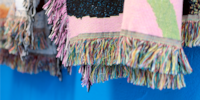

The Ariadne's thread that runs through all Liv Interior products
Katharina Gellert works as a designer and jack-of-all-trades for homeware brand Liv Interior. In this interview, she explains why she believes design can also convey messages.
At first, Katharina Gellert wasn't particularly keen on interior design. She studied fashion design in Hamburg and went on to found a sustainable fashion brand with others. What was missing? Sustainable trends. She finally found them at Liv Interior.
Since 2020, she has been designing interior textiles and taking on all retail-related tasks. Ideas are born in the Hamburg office, which also doubles as a showroom and boutique. Numerous rugs and other design pieces are on display here, revealing the style of the German-Danish brand. A perfect place to talk about the brand and Katharina's design leitmotif.
Why did Liv Interior specialise in textiles?
Katharina Gellert: the decision to specialise in linens was taken long before I arrived. But I know that the founder of Liv Interiors, Tina Mirza, has always been interested in it and that she loves knitting and crocheting. The first product was already a rug, and we still produce mainly rugs, not least because they give us so much pleasure. What's more, unlike other objects, they can still be easily made by hand.
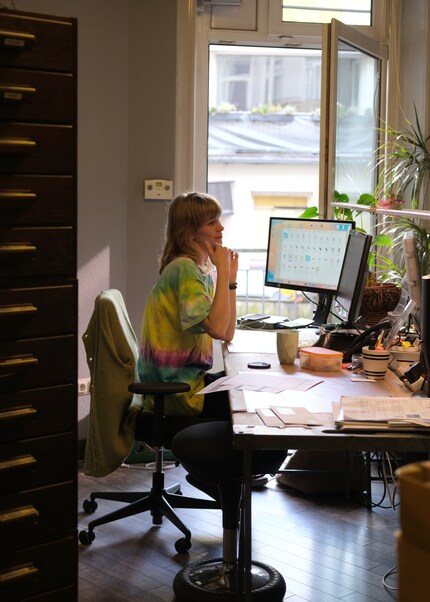
Source: Pia Seidel
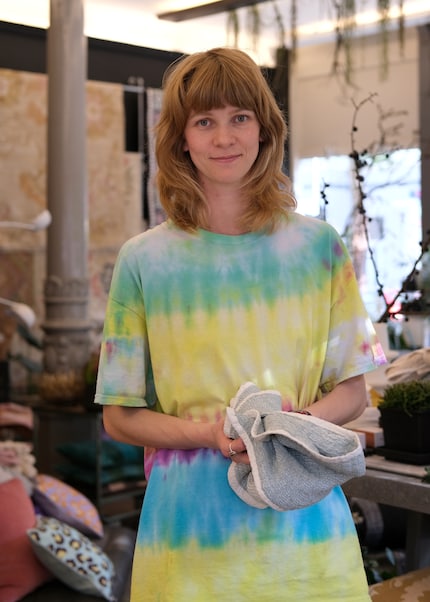
Source: Pia Seidel
Where do your collections see the light of day?
Most of them are produced in India. Only the ceramics and lampshades come from Vietnam. As we prefer shorter transport routes and want to monitor working conditions even more closely, towels have recently been sourced from Portugal and pillows and blankets from Austria. We're always thinking about the possibility of having more products produced in Europe.
What's stopping you?
We really enjoy working with our Indian partners and we don't want local craftsmanship to die out in India and jobs to disappear. Lately, we've already seen a change. It seems that more and more people are looking for office jobs. What's more, there are fewer and fewer weaving mills in Europe that are not automated. And even if one of them is suitable for us, they generally require us to order very large quantities. But we're still too small for that.
The "Dots" outdoor rug, which is around ten years old, is still a bestseller and is made from recycled plastic bottles. How is it made?
The carpet is made by our partner in India from recycled plastic bottles. They are collected, cleaned and shredded before being melted down. A fine thread is made from the melted material, from which our weaving workshops make beautiful rugs.
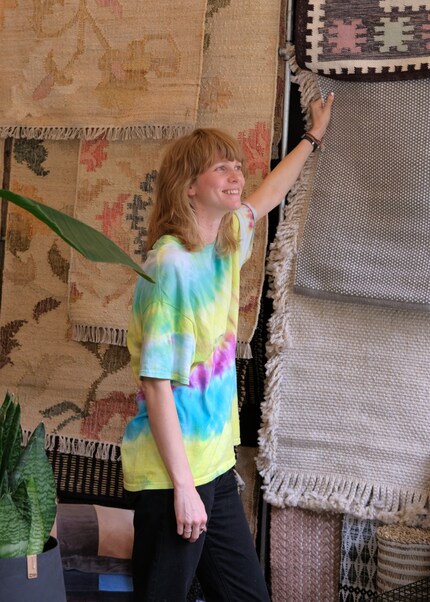
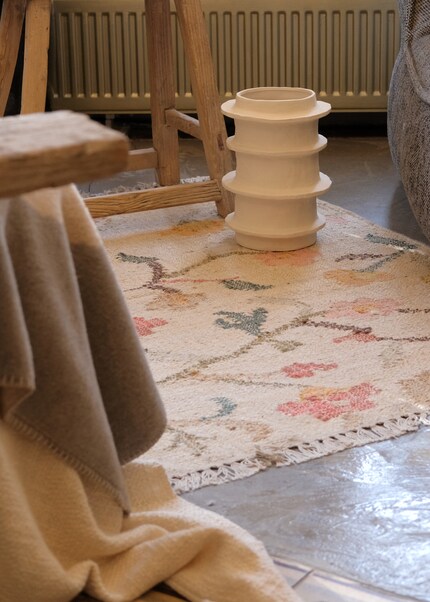
Does using recycled materials limit your creative output?
So far, we've always managed to turn our ideas into reality. The only exception is the rugs made from recycled organic cotton. The scraps of fabric that will later form the base are collected by colour and are not re-dyed. That's why we can only choose from an existing colour palette. The good thing is that no two models are alike.
There are many different sustainability certificates. Which one are you banking on?
Originally, we wanted to obtain the GOTS label. However, the cost of obtaining this label is very high and our team too small for it. The administrative work is also very heavy. But we very much hope that in the future there will be services for this, for example a label consultancy service, to which we can outsource this type of work professionally. Instead, we have the Goodweave label for all carpets and items made from recycled PET. The label guarantees both the protection of children from labour and respect for employee rights. The money from the label licence is also invested in children's education.
What inspires you when creating a new collection?
All sorts of things. Fashion trends, colour trend books, architectural movements like Bauhaus. When Tina discovers an interesting weaving technique while travelling, we also sometimes commission a small series there. Production often takes place in workshops in small villages. We provide them with the necessary equipment so that they can work on site. The snail-shaped lampshades, for example, were created in a village in Vietnam. The pashmina shawls come from a small mountain village in the Himalayan region.
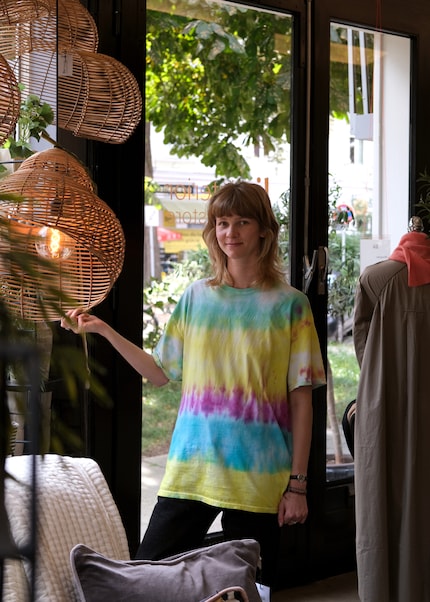
Source: Pia Seidel
Are there any products that don't work at all, unlike "Dots"?
Of course there are! Sometimes we're too impatient and want to incorporate a new textile design trend into our creations straight away. But it often takes at least a year before the trend reaches the mainstream. Two-tone cushion covers in geometric patterns are only just beginning to catch on. Yet they've been on the market for over a year.
Sometimes we're too impatient and want to incorporate a new textile design trend into our creations straight away. But it often takes at least a year for the trend to reach the mainstream.
Have you discovered anything else that is currently in vogue that we might perhaps come across more often in a year's time?
Yes, texture and touch are becoming more important. We seem to want to touch objects more again. But things are also changing in terms of appearance: organically shaped carpets are becoming increasingly popular.
This is probably linked to the 70s revival in interiors, which appeals with its organic shapes. Do you plan to incorporate this trend into your collection?
We're still waiting a little while. We prefer to start with small products like bath mats before launching into big designs.
Did any one product require more energy than others?
Yes, for two rugs, for example, we thought about a story: one is called "Human" and shows faces of different skin colours in profile. The other is called "Diversity" and shows the symbols of femininity and masculinity, but spinning them in such a way that they become unisex and their boundaries dissolve. That's what I love about design; conveying a message with a product.
That's what I love about design; conveying a message with a product.
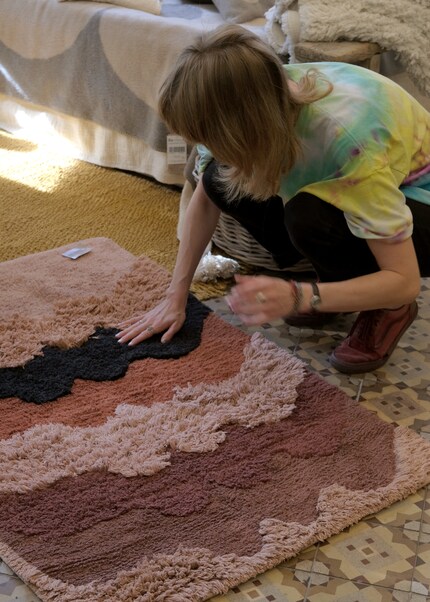
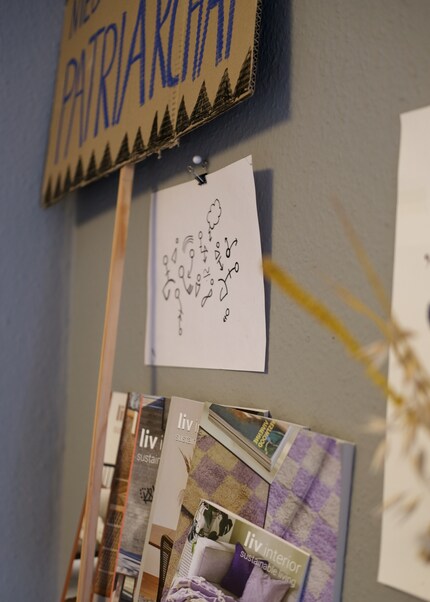
What is the breadcrumb trail that runs through your collection?
Multiculturalism, sustainability, but above all an interest in craftsmanship: where to use which fabrics and how. Right from the start, Tina was keen for us to be able to offer sustainable textiles at a fair price to a wide audience.

Liv Interior Pillowcase Faces 45 cm x 45 cm, Pink
45 x 45 cm

Liv Interior Wall decoration with beads 78 x 52 cm, palm fiber

Liv Interior Elements Blanket 180 x 130 cm, Multicoloured
8 x 37 x 54 cm

Liv Interior Carpet Dots 70 cm x 140 cm, Grey
70 x 140 cm

Liv Interior Jute storage basket 16 x 16 cm, Gold/Nature
1 x, 16 x 16 x 16 cm

Liv Interior Cotton rug Herringbone 70 cm x 140 cm, Green
70 x 140 cm
Who are these people who are constantly looking for better design solutions? Who create a new chair or table when they've already been around tens of thousands of times? In this series, I introduce you to these kinds of people. Follow my author profile to get a notification when the next one is published.
Headline photo: Pia Seidel
Like a cheerleader, I love celebrating good design and bringing you closer to everything furniture- and interior design- related. I regularly curate simple yet sophisticated interior ideas, report on trends and interview creative minds about their work.
Interesting facts about products, behind-the-scenes looks at manufacturers and deep-dives on interesting people.
Show all